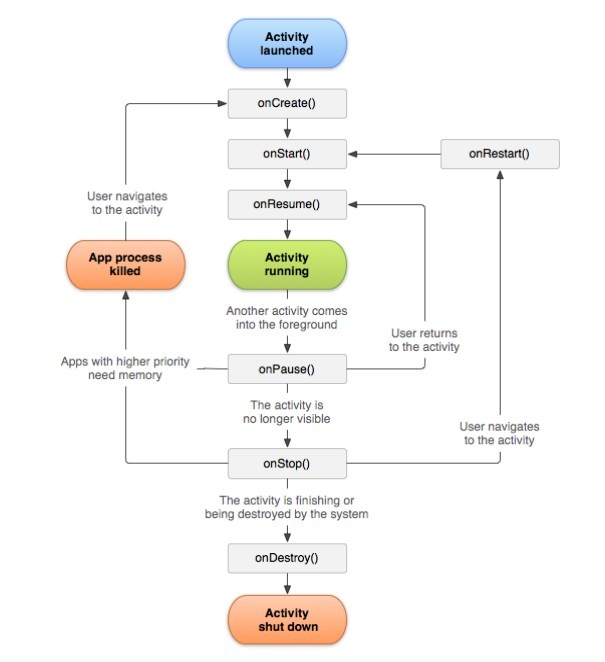
官方提供的Activity生命周期流程图:
官方提供的Activity生命周期一般流程表:
| Method | Description | Killable? | Next | ||
|---|---|---|---|---|---|
onCreate() |
Called when the activity is first created. This is where you should do all of your normal static set up: create views, bind data to lists, etc. This method also provides you with a Bundle containing the activity's previously frozen state, if there was one.
Always followed by |
No | onStart() |
||
onRestart() |
Called after your activity has been stopped, prior to it being started again.
Always followed by |
No | onStart() |
||
onStart() |
Called when the activity is becoming visible to the user.
Followed by |
No | onResume() or onStop() |
||
onResume() |
Called when the activity will start interacting with the user. At this point your activity is at the top of the activity stack, with user input going to it.
Always followed by |
No | onPause() |
||
onPause() |
Called when the system is about to start resuming a previous activity. This is typically used to commit unsaved changes to persistent data, stop animations and other things that may be consuming CPU, etc. Implementations of this method must be very quick because the next activity will not be resumed until this method returns.
Followed by either |
Pre-HONEYCOMB |
onResume() oronStop() |
||
onStop() |
Called when the activity is no longer visible to the user, because another activity has been resumed and is covering this one. This may happen either because a new activity is being started, an existing one is being brought in front of this one, or this one is being destroyed.
Followed by either |
Yes | onRestart() oronDestroy() |
||
onDestroy() |
The final call you receive before your activity is destroyed. This can happen either because the activity is finishing (someone called finish() on it, or because the system is temporarily destroying this instance of the activity to save space. You can distinguish between these two scenarios with the isFinishing() method. |
Yes | nothing | ||